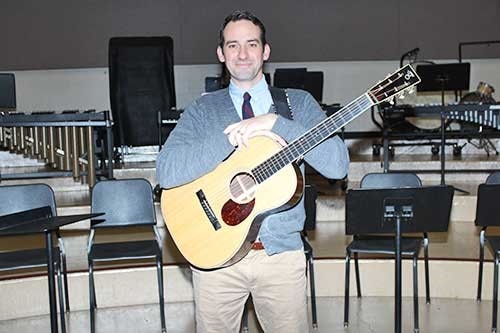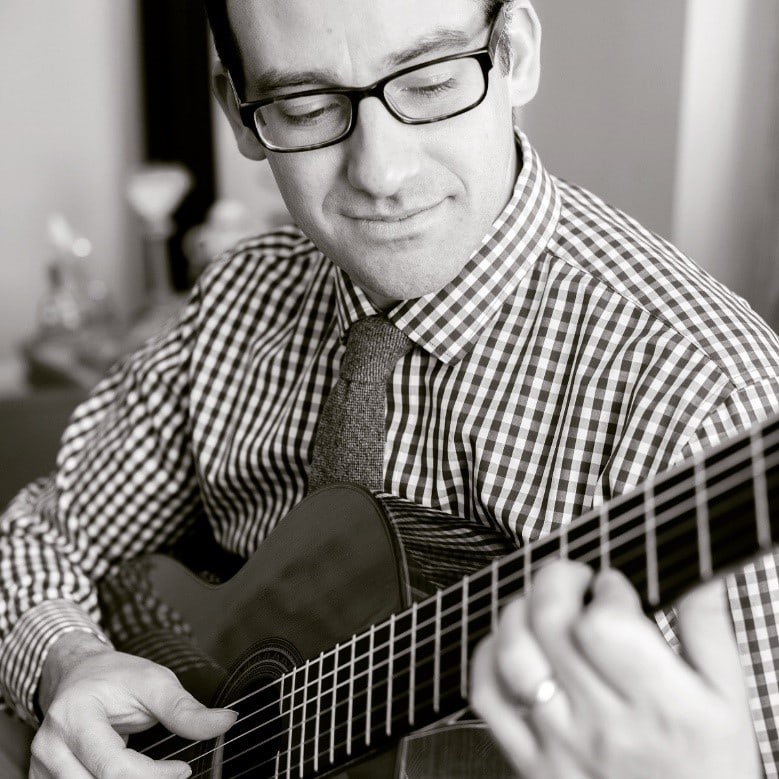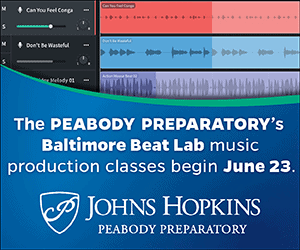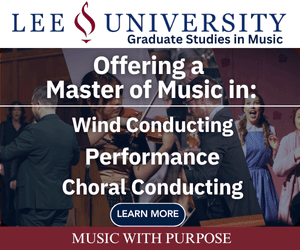/ News Posts / Guitar Class in the Bay State
Guitar Class in the Bay State
Number 35: The Commonwealth of Massachusetts
By Thomas Amoriello Jr.
NAfME Council for Guitar Education Chair
The NAfME Council for Guitar Education introduces Harry Wagg, who was recently appointed chair of the guitar education council for the Massachusetts Music Educators Association. Currently he is the instrumental director at Lynnfield High School, where he leads a fairly innovative program that has a heavy focus on small ensembles, improvisation, creative decision-making, and inclusion. As a guitarist, Mr. Wagg is passionate about guitar education in general, but specifically how the guitar (as well as ukulele, mandolin, and other fretted instruments) can be included and used in school band and general music programs.
A graduate from music programs at Berklee College of Music and Boston University (MA in Music Education), he performs at venues throughout New England for events and special occasions. His repertoire consists of traditional jazz standards and contemporary tunes arranged for solo guitar. Harry Wagg lives in Ipswich, Massachusetts, and is a proud husband and father (to both humans and dogs). Thank you, Harry, for sharing your knowledge with the NAfME membership.
Please tell us about your school and overall music program.
I teach at Lynnfield High School, and I am the instrumental director for a program composed of small ensembles that perform mostly contemporary music. We really embrace student repertoire choice, improvisation, songwriting/composition, and a tiered learning experience. Guitars are welcome in all ensembles and are a huge part of our music program.
How do the guitar family of instruments fit into your teaching?
I welcome guitarists into all our ensembles. The versatility of the instrument allows them to contribute to ensembles, no matter what their skill level is. We have students learning to pluck single notes following the basic harmonic structure, strumming chords and learning new shapes while increasing dexterity, working on reading skills, or gaining confidence by being a featured soloist.
“As a guitarist in a music education program, it can be easy to feel a bit like an outlier. But my professors really encouraged their students to be creative thinkers who weren’t afraid to venture outside the box. I’ve tried to pass on these same ideals to my students.”
What obstacles did you face when you were first hired at your school? Now?
I’ve been lucky in my position—I haven’t faced many obstacles. The administration has been very supportive of any ideas I think might benefit the program. The previous band director, Tom Westmoreland, has been very involved with our state Innovation Committee and set up a program that is quite innovative, and works well for the unique needs of the community. I’m very thankful for the creative freedom and flexibility I have to try new things.
What kind of classes related to the guitar do you teach?
In past years, I have lead guitar ensembles as part of our after-school program, and will be leading one again this year as a “morning band” (an extracurricular ensemble composed of students looking for some more playing time and willing to wake up early.) However, guitars are really integrated into every class and ensemble. From concert band, to jazz and rock ensembles and our pep band, guitars are there!
What would you like to say to the non-guitarist music educator who is about to include or is interested in incorporating the guitar into their program?
Start by familiarizing yourself with the instrument. If you’ve never played before, take note of the obstacles you encounter, work with a teacher to help you strategize how to overcome them, and realize that your students will most likely need the same strategies for the same issues. I would also encourage educators to find help within their school communities. There are most likely people right in your building who have experience playing guitar, even if it’s just strumming a few chords. Finally, be prepared and excited to have some really passionate musicians in your program!
“But what I love to see most are the students who slowly and steadily turn the music room into their home away from home. The students who pop in any time they have a free moment. The students who rush down as soon as school is out and start strumming away. I’m really proud to play a part, no matter how small, in them finding their musical voice and watching them become part of a community that will hopefully impact their lives in immeasurable ways for years to come.”
What do you tell your talented students who are planning to pursue music or guitar studies in high school or college after they finish with you?
I tell them to take every playing opportunity that comes their way. Play with their peers, learn from players who are more experienced, lead players of lesser ability, and immerse themselves in a variety of genres.
Do you have any networking or advocacy tools that have worked for you promoting your program that would help other educators?
Get out into the community and feature your talented musicians. Sometimes it’s easy to forget that parents, community members, administrators, other students, etc., don’t get to see what amazing musicians we get to work with on a day-to-day basis. As a music educator, it’s part of our job to show them off! It builds student confidence, garners support from the community, and helps recruit new students.
Do you have any success stories you would like to share about students (musical and non-musical)?
We’ve had lots of success stories. Last year three of the seniors went on to music school, which was a great testament to the program, and the hard work those students put in. But what I love to see most are the students who slowly and steadily turn the music room into their home away from home. The students who pop in any time they have a free moment. The students who rush down as soon as school is out and start strumming away. I’m really proud to play a part, no matter how small, in them finding their musical voice and watching them become part of a community that will hopefully impact their lives in immeasurable ways for years to come.
Please tell us about your own personal musical background growing up and your collegiate experience.
I was lucky to be surrounded by music growing up. My grandfather and father were both trumpet players, so I followed suit and was very actively involved in music through middle school. Unfortunately, the high school I attended didn’t have much of a music department until my senior year.
Without a traditional program, I drifted away from trumpet, but found my way to the guitar. Like most young guitarists, I fell right into rock, blues, and eventually jazz which lead me to Berklee College of Music. After graduating, I worked and played in New York for several years before returning to Berklee to complete the music education program. As a guitarist in a music education program, it can be easy to feel a bit like an outlier. But my professors really encouraged their students to be creative thinkers who weren’t afraid to venture outside the box. I’ve tried to pass on these same ideals to my students.
What kind of future do you see for guitar in music education in Massachusetts schools?
I see a lot of programs embracing smaller ensembles and contemporary musical styles. I believe that these types of ensembles create excitement in the students and are warmly embraced by the community. The successes of programs like these will encourage districts to embrace them, and hopefully guitarists will have a place in every band program throughout the state.
What type of lesson plans have you done for your classes that may be unique?
One thing I find is that students are interested in improvisation, but it can be intimidating at first. Too often I hear of students given a scale and told to “make something up.” While this works for certain individuals, others can find this to be too blank of a slate. So, one thing I have done is use snippets from famous solos as warm-up exercises for the entire band. It’s like giving them small bits of conversational language that they can use and personalize in their improvisations.
Are you involved in any musical performances or activities outside of your public school teaching duties?
I perform fairly regularly on the north shore of Massachusetts, as well as throughout New England as a solo guitarist. Having a family with two small children and being a band director can make rehearsing with groups on a regular basis a challenge. However, I can almost always sneak in time to practice solo repertoire. The capability of the guitar to perform solo is one of the things I love about the instrument as well. That said, I do perform with some local big band groups on a less regular basis, which is great fun too.
Any last thoughts to conclude our interview?
Nope . . . all this guitar talk has made me want to go play!
Past “Guitar Class in 50 States” articles:
- Number 50: The Granite State (New Hampshire)
- Number 49: The Green Mountain State (Vermont)
- Number 48: The Mountain State (West Virginia)
- Number 47: The Hoosier State (Indiana)
- Number 46: The Mount Rushmore State (South Dakota)
- Number 45: The Pine Tree State (Maine)
- Number 44: The Badger State (Wisconsin)
- Number 43: The Constitution State (Connecticut)
- Number 42: The Evergreen State (Washington)
- Number 41: The Pelican State (Louisiana)
- Number 40: The Beaver State (Oregon)
- Number 39: The Equality State (Wyoming)
- Number 38: The Empire State (New York)
- Number 37: The Old Line State (Maryland)
- Number 36: The Centennial State (Colorado)
- Number 34: The Sooner State (Oklahoma)
- Number 33: The Prairie State (Illinois)
- Number 32: The Hawkeye State (Iowa)
- Number 31: The Volunteer State (Tennessee)
- Number 30: The Palmetto State (South Carolina)
- Number 29: The Natural State (Arkansas)
- Number 28: The Tar Heel State (North Carolina)
- Number 27: The Magnolia State (Mississippi)
- Number 26: The Peace Garden State (North Dakota)
- Number 25: The Treasure State (Montana)
- Number 24: The First State (Delaware)
- Number 23: The Buckeye State (Ohio)
- Number 22: The Yellowhammer State (Alabama)
- Number 21: The Sunflower State (Kansas)
- Number 20: The Great Lakes State (Michigan)
- Number 19: The Lone Star State (Texas)
- Number 18: The Bluegrass State (Kentucky)
- Number 17: The Golden State (California)
- Number 16: The Show-Me State (Missouri)
- Number 15: The Keystone State (Pennsylvania)
- Number 14: The Last Frontier State (Alaska)
- Number 13: The Beehive State (Utah)
- Number 12: The Peach State (Georgia)
- Number 11: The Cornhusker State (Nebraska)
- Number 10: The Gem State (Idaho)
- Number 9: The Old Dominion (Virginia)
- Number 8: The Aloha State (Hawaii)
- Number 7: The Land of Enchantment (New Mexico)
- Number 6: The Sunshine State (Florida)
- Number 5: The Grand Canyon State (Arizona)
- Number 4: The Ocean State (Rhode Island)
- Number 3: The North Star State (Minnesota)
- Number 2: The Silver State (Nevada)
- Number 1: The Garden State (New Jersey)
About the author:
 Thomas Amoriello Jr. serves as the chair on the NAfME Council for Guitar Education and is also the former Chairperson for the New Jersey Music Education Association. Tom has taught guitar classes for the Flemington Raritan School District in Flemington, New Jersey, since 2005 and was also an adjunct guitar instructor at Cumberland County College, New Jersey, for five years. He has earned a Master of Music Degree in Classical Guitar Performance from Shenandoah Conservatory and a Bachelor of Arts in Music from Rowan University. He is the author of the children’s picture books A Journey to Guitarland with Maestro Armadillo and Ukulele Sam Strums in the Sand, both available from Black Rose Writing. He recently made a heavy metal recording with a stellar roster of musicians including former members of Black Sabbath, Whitesnake, Ozzy Osbourne, Yngwie J. Malmsteen’s Rising Force, and Dio that was released on H42 Records of Hamburg, Germany. The record released on 12-inch vinyl and digital platforms has received favorable reviews in many European rock magazines and appeared on the 2018 Top 15 Metal Albums list by Los Angeles KNAC Radio (Contributor Dr. Metal). Visit thomasamoriello.com for more information.
Thomas Amoriello Jr. serves as the chair on the NAfME Council for Guitar Education and is also the former Chairperson for the New Jersey Music Education Association. Tom has taught guitar classes for the Flemington Raritan School District in Flemington, New Jersey, since 2005 and was also an adjunct guitar instructor at Cumberland County College, New Jersey, for five years. He has earned a Master of Music Degree in Classical Guitar Performance from Shenandoah Conservatory and a Bachelor of Arts in Music from Rowan University. He is the author of the children’s picture books A Journey to Guitarland with Maestro Armadillo and Ukulele Sam Strums in the Sand, both available from Black Rose Writing. He recently made a heavy metal recording with a stellar roster of musicians including former members of Black Sabbath, Whitesnake, Ozzy Osbourne, Yngwie J. Malmsteen’s Rising Force, and Dio that was released on H42 Records of Hamburg, Germany. The record released on 12-inch vinyl and digital platforms has received favorable reviews in many European rock magazines and appeared on the 2018 Top 15 Metal Albums list by Los Angeles KNAC Radio (Contributor Dr. Metal). Visit thomasamoriello.com for more information.
Interested in reprinting this article? Please review the reprint guidelines.
The National Association for Music Education (NAfME) provides a number of forums for the sharing of information and opinion, including blogs and postings on our website, articles and columns in our magazines and journals, and postings to our Amplify member portal. Unless specifically noted, the views expressed in these media do not necessarily represent the policy or views of the Association, its officers, or its employees.
Catherina Hurlburt, Marketing Communications Manager. November 21, 2019. © National Association for Music Education (NAfME.org)
Published Date
November 21, 2019
Category
- Ensembles
Copyright
November 21, 2019. © National Association for Music Education (NAfME.org)







